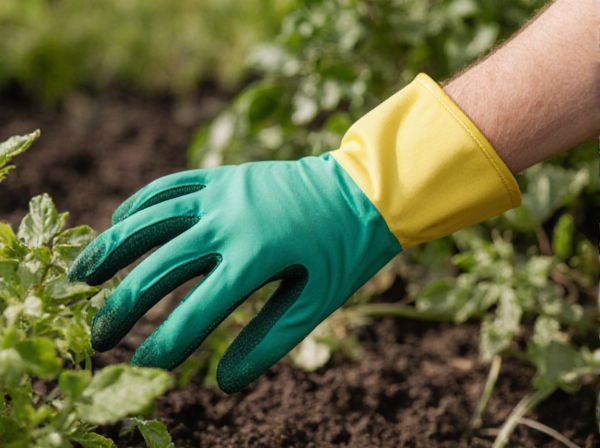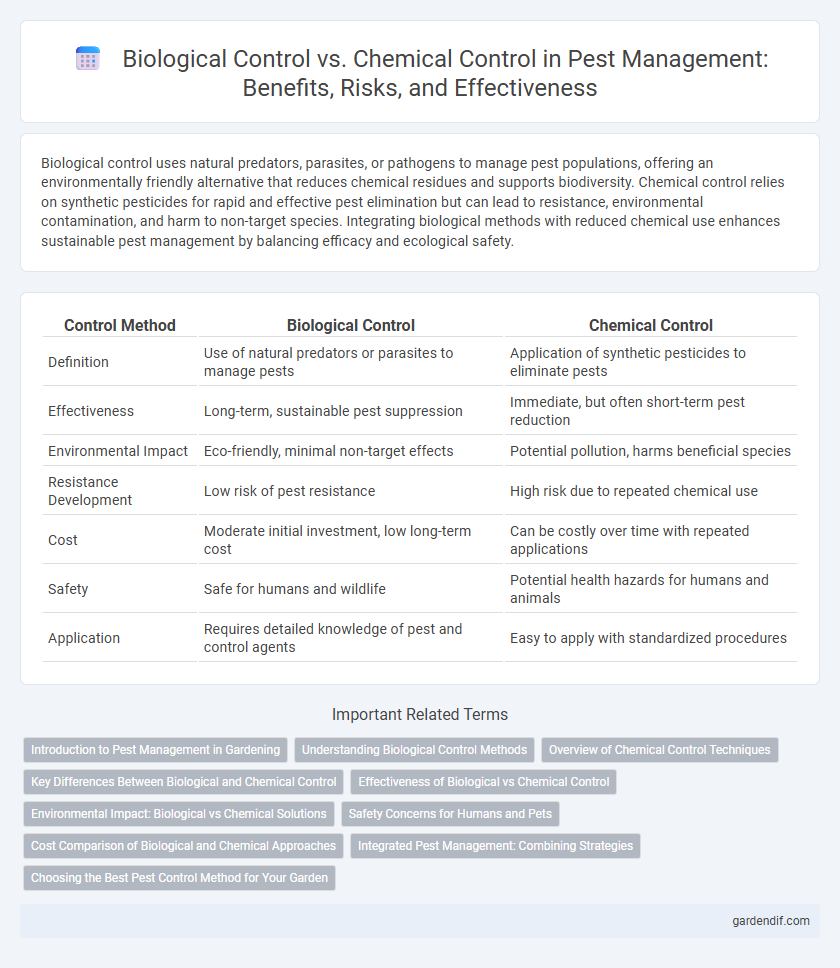
biological control vs chemical control Illustration
Biological control uses natural predators, parasites, or pathogens to manage pest populations, offering an environmentally friendly alternative that reduces chemical residues and supports biodiversity. Chemical control relies on synthetic pesticides for rapid and effective pest elimination but can lead to resistance, environmental contamination, and harm to non-target species. Integrating biological methods with reduced chemical use enhances sustainable pest management by balancing efficacy and ecological safety.
Table of Comparison
| Control Method | Biological Control | Chemical Control |
|---|---|---|
| Definition | Use of natural predators or parasites to manage pests | Application of synthetic pesticides to eliminate pests |
| Effectiveness | Long-term, sustainable pest suppression | Immediate, but often short-term pest reduction |
| Environmental Impact | Eco-friendly, minimal non-target effects | Potential pollution, harms beneficial species |
| Resistance Development | Low risk of pest resistance | High risk due to repeated chemical use |
| Cost | Moderate initial investment, low long-term cost | Can be costly over time with repeated applications |
| Safety | Safe for humans and wildlife | Potential health hazards for humans and animals |
| Application | Requires detailed knowledge of pest and control agents | Easy to apply with standardized procedures |
Introduction to Pest Management in Gardening
Biological control in pest management utilizes natural predators, parasites, or pathogens to reduce pest populations, promoting sustainable and environmentally friendly gardening practices. Chemical control relies on synthetic pesticides, offering rapid pest reduction but posing risks of resistance development, environmental contamination, and harm to beneficial organisms. Integrating biological control methods within gardening pest management enhances long-term efficacy and minimizes negative impacts on garden ecosystems.
Understanding Biological Control Methods
Biological control methods utilize natural predators, parasites, or pathogens to manage pest populations, reducing reliance on harmful chemical pesticides. This strategy promotes ecological balance by targeting specific pests without damaging beneficial organisms or the environment. Implementing biological control supports sustainable agriculture and minimizes chemical residues in crops and soil.
Overview of Chemical Control Techniques
Chemical control techniques involve the application of synthetic pesticides such as insecticides, herbicides, and fungicides to manage pest populations effectively. These methods offer rapid pest suppression and are widely used in agricultural and urban settings due to their ease of application and immediate results. However, reliance on chemical control can lead to issues such as pesticide resistance, environmental contamination, and non-target species harm, necessitating integrated pest management strategies for sustainable use.
Key Differences Between Biological and Chemical Control
Biological control utilizes natural predators, parasites, or pathogens to manage pest populations, promoting environmental sustainability and minimizing chemical residues. Chemical control relies on synthetic pesticides that provide rapid, broad-spectrum pest elimination but can lead to resistance, non-target species harm, and environmental pollution. Key differences include specificity, environmental impact, resistance development, and long-term effectiveness in pest management strategies.
Effectiveness of Biological vs Chemical Control
Biological control uses natural predators or parasites to reduce pest populations, offering sustainable and long-term pest management without harmful residues. Chemical control provides rapid and broad-spectrum pest elimination but poses risks of resistance development and environmental contamination. Studies indicate that integrating biological control with selective chemical use often enhances overall effectiveness while minimizing ecological impact.
Environmental Impact: Biological vs Chemical Solutions
Biological control methods utilize natural predators, parasites, or pathogens to manage pest populations, resulting in minimal environmental disruption and promoting biodiversity. Chemical control relies on synthetic pesticides that can contaminate soil, water, and non-target species, leading to long-term ecological damage and pesticide resistance. Emphasizing biological solutions reduces chemical residues and supports sustainable agricultural practices.
Safety Concerns for Humans and Pets
Biological control methods, such as introducing natural predators or using microbial agents, pose minimal risks to human health and pets, making them a safer alternative to chemical pesticides. Chemical control often involves toxic substances that can cause acute poisoning, allergic reactions, and long-term health issues in humans and animals exposed to residues or drift. Prioritizing biological control reduces environmental contamination and the likelihood of accidental poisonings, ensuring safer pest management in residential and agricultural settings.
Cost Comparison of Biological and Chemical Approaches
Biological control often incurs higher initial costs due to the need for research, rearing, and release of natural predators or parasites, yet it tends to offer sustainable, long-term pest management without repeated expenditures. Chemical control typically involves lower upfront expenses but can lead to increased costs over time from repeated applications, pesticide resistance, and environmental remediation. Economic analyses frequently show that integrating biological control reduces overall pest management costs by minimizing chemical inputs and associated health and ecological risks.
Integrated Pest Management: Combining Strategies
Integrated Pest Management (IPM) combines biological control agents like parasitoids and predators with selective chemical applications to minimize pest populations effectively while reducing environmental impact. This strategy enhances sustainability by promoting natural pest resistance and decreasing pesticide resistance development. Emphasizing pest monitoring and threshold levels ensures targeted treatments, optimizing crop health and yield.
Choosing the Best Pest Control Method for Your Garden
Biological control uses natural predators or parasites to manage pest populations, offering an eco-friendly alternative that preserves beneficial insects and soil health. Chemical control delivers rapid, targeted pest elimination but may harm non-target organisms and contribute to pesticide resistance. Selecting the best pest control method for your garden depends on pest severity, plant sensitivity, environmental impact, and long-term sustainability goals.
biological control vs chemical control Infographic

 gardendif.com
gardendif.com